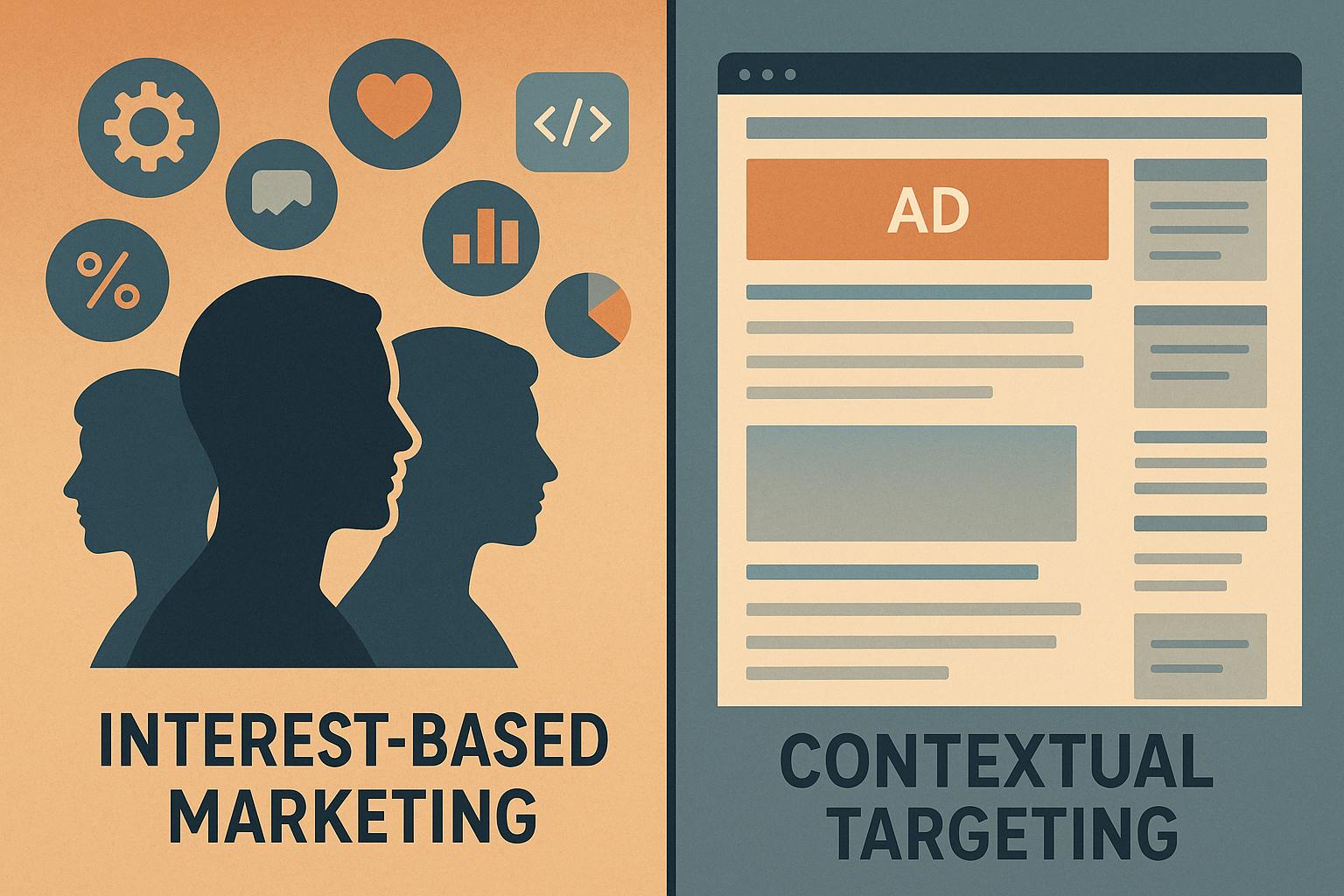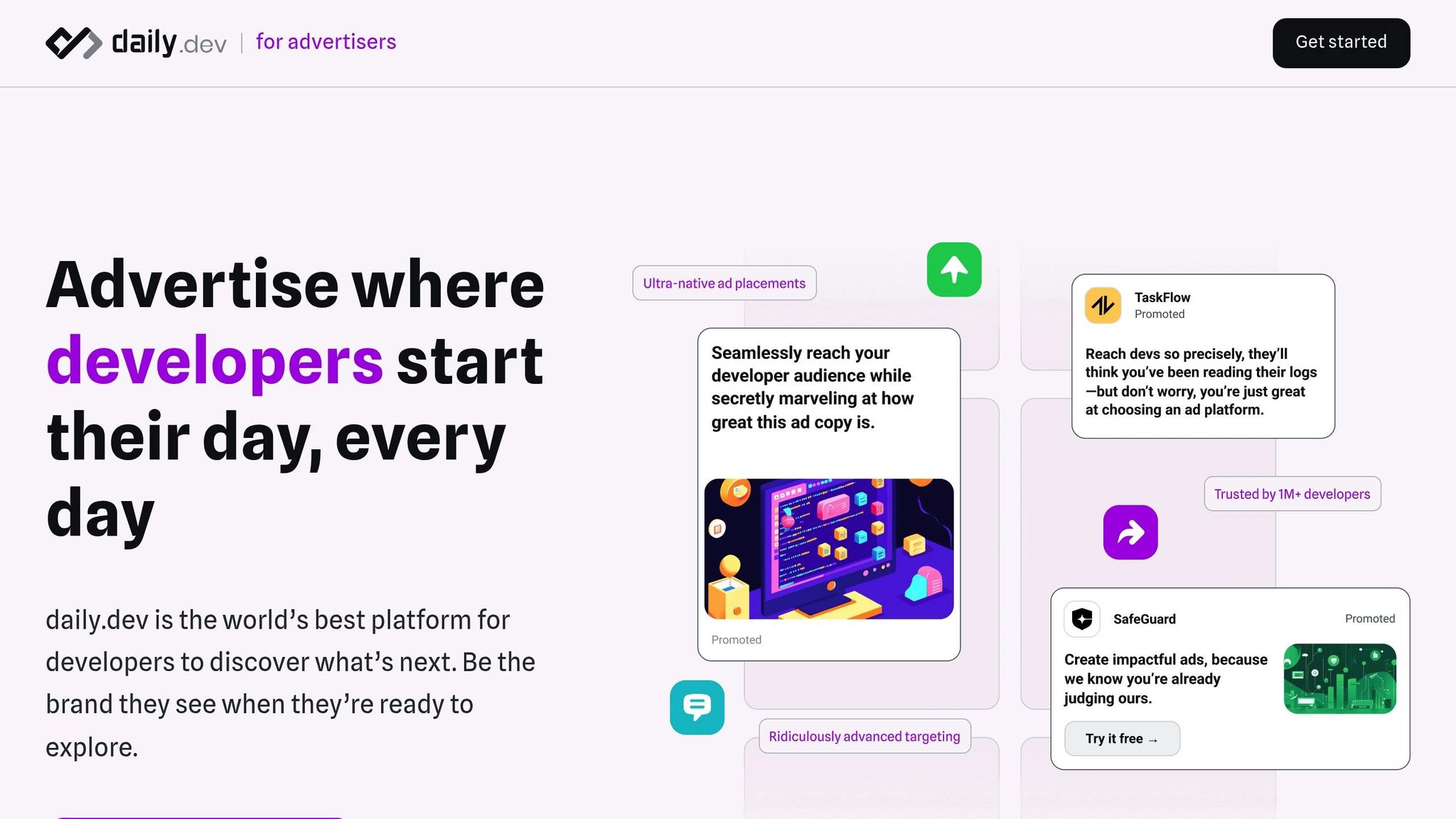


Explore the differences between interest-based marketing and contextual targeting for optimal ad performance and ROI in developer-focused campaigns.
Looking to improve your ad performance? Here’s the bottom line: interest-based marketing and contextual targeting both work, but in different ways.
- Interest-Based Marketing targets users based on their browsing habits and preferences. It’s ideal for long-term engagement and retargeting campaigns but requires more data and is costlier.
- Contextual Targeting places ads based on the content users are viewing at the moment. It’s faster, privacy-friendly, and works well for immediate relevance, especially in educational or niche content.
Key takeaway: Use contextual targeting for quick results and privacy compliance. Use interest-based marketing for precise, data-driven campaigns. Combining both can maximize ROI for developer-focused advertising.
Quick Comparison:
| Feature | Interest-Based Marketing | Contextual Targeting |
|---|---|---|
| Data Use | Relies on user behavior data | Analyzes page content only |
| Privacy Impact | Higher due to tracking | Low, no personal data needed |
| Cost | More expensive | Budget-friendly |
| Relevance | Personalized over time | Immediate to current content |
| Setup | Complex audience profiles | Simple keyword/content focus |
Platforms like daily.dev Ads combine both strategies, offering flexibility to tailor campaigns for better results. Start with contextual targeting for awareness and layer in interest-based ads for deeper engagement.
Contextual AI Unlocks New Targeting Options and Insights for CTV Advertising
How Interest-Based Marketing Works
Interest-based marketing uses behavioral data to group developers into specific categories and deliver ads that align with their interests. By analyzing browsing habits, tool preferences, and engagement patterns, advanced algorithms can identify developers interested in areas like machine learning frameworks, cloud infrastructure, or mobile development. This precise targeting ensures that ads resonate with the right audience, improving ad effectiveness and maximizing ROI.
The process relies on data-driven insights to guide ad placement strategies, which will be explored further in the next section.
How Contextual Targeting Works
Unlike interest-based marketing, which relies on a user's historical data, contextual targeting zeroes in on the content someone is engaging with right now. Instead of tracking past behavior, this approach analyzes the real-time content a developer is reading and aligns ads to that specific context. The result? Highly relevant ad placements that don't require personal data collection.
Contextual Targeting Methods
At its core, contextual targeting uses content analysis and keyword matching to determine ad placement. For instance, if a developer is reading an article about Kubernetes deployment strategies, the system scans the content for relevant terms, topics, and themes. Advanced systems go a step further, employing natural language processing (NLP) to grasp not just individual keywords but also the broader intent and subject matter of the content.
Modern techniques also include semantic analysis, which recognizes related concepts even if specific keywords aren't present. For example, an article about "container orchestration" might trigger ads for Docker-related tools, even if the term "Docker" isn’t explicitly mentioned.
Machine learning algorithms play a key role, evaluating content quality, relevance, and context in real time. This ensures ads are placed alongside content that truly aligns with the advertiser's goals, rather than just matching a few isolated keywords.
Benefits of Contextual Targeting
One of the biggest advantages of contextual targeting is its privacy-friendly nature. Since it doesn't track users or collect personal data, it naturally complies with privacy regulations like GDPR and CCPA. For developers - who often prioritize privacy - this approach is particularly appealing.
Another major benefit is immediate relevance. When developers are actively reading about a specific technology or challenge, they’re already in the right mindset to consider tools or solutions related to that topic. This alignment often leads to higher engagement, as the ads feel like a natural part of the content rather than a disruptive interruption.
Contextual targeting also offers simplified campaign setup. Instead of creating complex audience segments based on user behavior, advertisers can focus on identifying the types of content their target audience engages with. This streamlined process makes it easier for companies, especially those with limited advertising expertise, to launch effective campaigns.
Additionally, contextual targeting provides brand safety. Since ads are placed based on content analysis, companies can ensure their ads appear in environments that align with their brand values. For developer-focused brands, this is crucial for maintaining technical credibility.
When Contextual Targeting Works Best
Contextual targeting shines in several scenarios:
- New product launches: For brand-new tools or technologies, where no behavioral data exists, contextual ads can connect with developers already exploring related topics.
- Educational content campaigns: Ads placed next to tutorials, technical guides, or documentation are highly effective since developers in a learning mode are more open to discovering solutions to their challenges.
- Privacy-focused campaigns: Companies emphasizing data privacy can use contextual targeting to reinforce their privacy-first approach, resonating with developers who value data protection.
- Seasonal or event-driven campaigns: During major developer events or product announcements, contextual ads can tap into the heightened interest without waiting for behavioral data to catch up.
- Niche technical topics: In specialized areas - like a specific programming language or framework - contextual targeting can reach small but highly engaged developer communities that behavioral targeting might overlook.
sbb-itb-e54ba74
ROI Comparison: Interest-Based vs Contextual Targeting
When it comes to boosting ROI in developer advertising, interest-based marketing and contextual targeting each bring unique strengths to the table. These strategies are essential for creating campaigns that respect developer privacy while delivering measurable results.
Key Metrics Comparison
The main differences between these two targeting methods become clear when you break down the metrics that directly influence ROI:
| Metric | Interest-Based Marketing | Contextual Targeting |
|---|---|---|
| Data Requirements | Relies on extensive user behavioral data | Focuses on analyzing content rather than user data |
| Privacy Impact | Higher due to tracking and consent needs | Lower, as it avoids personal data collection |
| Setup Complexity | More complex, requiring detailed audience segmentation | Simpler, with content-driven targeting |
| Ad Relevance | Excels for returning users with historical data | Offers immediate relevance by matching current content |
| Cost Efficiency | Typically more expensive due to data processing | More budget-friendly with minimal data overhead |
| Campaign Launch Speed | Slower, as it requires building detailed audience profiles | Faster, thanks to immediate content alignment |
Interest-based marketing thrives on refining audience segments using historical behavior, making it ideal for nurturing long-term relationships. Meanwhile, contextual targeting allows for quick deployment by aligning ads with relevant content, making it perfect for fast-paced campaigns. Choosing between the two depends on your campaign's specific goals - whether you prioritize speed or deeper audience connection.
ROI Performance Case Studies
Case studies reveal that contextual targeting excels at driving quick results by aligning ads with relevant content. On the other hand, interest-based marketing shines in fostering long-term engagement through detailed behavioral insights. These findings shape how daily.dev Ads combines both approaches to deliver top-tier ROI.
How daily.dev Ads Uses Both Methods

daily.dev Ads takes a hybrid approach, combining real-time content analysis with behavioral insights from over 1 million developers. This ensures precise audience targeting and immediate ad visibility.
This dual strategy allows advertisers to launch campaigns quickly using contextual placements while gradually optimizing for high-value developer segments as more data becomes available. With real-time tracking and advanced targeting capabilities, advertisers can fine-tune campaigns dynamically to maximize ROI.
Choosing the Right Strategy for Developer Campaigns
Picking the right targeting strategy for your developer campaigns is essential to get the most out of your investment. Whether you go with interest-based marketing, contextual targeting, or a mix of both, your decision should align with your goals, budget, and the needs of your audience.
How to Select the Right Approach
Your campaign goals should be the compass for your targeting strategy. If you're working with a tight budget, contextual targeting is a more affordable option to get started. On the other hand, interest-based marketing often requires a bigger investment due to the need for processing user data, especially in regions with strict data privacy rules.
For campaigns that need to launch quickly, contextual targeting offers a straightforward solution. Meanwhile, established brands with access to detailed user data can dive deeper with interest-based marketing to build stronger connections.
The quality of your existing audience data is another factor to weigh. If you're a new player in the developer market, contextual targeting can help you build brand awareness from the ground up. But if you already have behavioral data, interest-based marketing offers the chance to create more refined audience segments.
These factors help clarify when each approach will be most effective.
When to Use Each Targeting Method
Once you've considered your goals and resources, you can identify the best situations for each targeting method.
Contextual targeting works well when your goal is to promote developer tools that solve immediate problems. For instance, placing an ad for a debugging tool alongside articles about troubleshooting code creates a natural connection between the content and your solution. This method is particularly effective for educational content, documentation platforms, and technical tutorials, where developers are actively searching for practical answers.
Interest-based marketing shines when campaigns need more advanced audience segmentation. Retargeting is a great example - it allows you to re-engage developers who have already interacted with your content or visited specific product pages. This approach is ideal for high-value offerings like premium developer tools or enterprise solutions, where understanding user preferences - such as programming languages or technology stacks - can significantly boost conversion rates.
The type of campaign you're running also plays a role in choosing a strategy. For broad awareness campaigns, such as introducing a new developer tool, contextual targeting can help you reach a wide audience through relevant content placements. But if your campaign is focused on specific developer groups, like mobile developers or DevOps engineers, interest-based marketing provides the precision you need.
Using Both Strategies Together
Platforms like daily.dev Ads make it easy to combine the immediacy of contextual targeting with the precision of interest-based marketing. You can start with contextual placements to build awareness and gather initial data, then layer in interest-based targeting to fine-tune your approach and drive conversions.
By blending these methods, you can use insights from one to improve the other. For example, data from contextual campaigns - like identifying content themes that perform well - can help you refine your interest-based audience segments. Similarly, behavioral data from interest-based campaigns can guide your selection of contextual keywords and topics.
When using both strategies, it’s smart to allocate the majority of your budget to the method that aligns best with your primary campaign goals. Set aside a smaller portion for testing the secondary method to ensure your campaign covers all bases without losing focus.
Real-time optimization tools on platforms like daily.dev Ads allow you to adjust your strategy based on performance. If contextual placements are driving strong engagement, the system can prioritize similar content. Conversely, if certain audience segments are converting well, interest-based targeting can be scaled to reach more developers with similar profiles.
Finally, tailor your ad creative to each method. Contextual ads should tie directly to the surrounding content, while interest-based ads should focus on personalized messaging and user-specific benefits. With daily.dev Ads’ creative guidance, you can design ad sets that perform well in both contexts while maintaining consistent branding throughout your campaign.
Conclusion: Improving Developer Advertising Results
Combining interest-based marketing with contextual targeting can significantly enhance ROI in developer advertising campaigns.
Contextual targeting shines when developers are actively searching for solutions. Its cost-effectiveness, privacy-friendly nature, and immediate relevance make it particularly effective for promoting educational materials and technical resources.
On the other hand, interest-based marketing offers laser-focused precision for targeting specific audiences. While it often requires a higher investment and adherence to strict privacy standards, its ability to retarget engaged developers can make the extra cost worthwhile.
The most effective campaigns integrate both strategies. Use contextual targeting to create initial awareness and interest, then leverage interest-based marketing to fine-tune audience segmentation and drive conversions. This combination ensures every stage of your campaign - from launch to sustained engagement - is optimized for maximum ROI.
Platforms like daily.dev Ads simplify this process by offering both contextual placements and precise interest-based targeting in one solution. Their real-time optimization tools allow you to adjust strategies on the fly, ensuring your budget is directed toward the approaches that perform best.
To achieve the best results, align your targeting method with your campaign's goals, budget, and timeline. For short-term campaigns, contextual targeting works best. For long-term engagement, interest-based strategies are more effective. Continuously analyze performance data and refine your approach to keep improving outcomes.
Ultimately, success in developer advertising hinges on understanding what developers value most: relevance and authenticity. Whether you're using contextual targeting or interest-based marketing, your ads must provide real value and respect the developer's time. With the right strategy and tools, both approaches can deliver the ROI improvements your campaigns need.
FAQs
How can combining interest-based marketing and contextual targeting improve ROI in developer-focused advertising?
Combining interest-based marketing with contextual targeting can be a game-changer for improving ROI. Each approach brings something unique to the table: interest-based marketing helps you connect with developers by focusing on their long-term preferences and behaviors, making your ads more aligned with their professional passions. Meanwhile, contextual targeting ensures your ads show up in the most relevant places, matching the content they’re already engaging with.
When you integrate these two strategies, you get the best of both worlds - precision and relevance. For instance, you could use interest-based insights to identify developers who are passionate about a specific programming language. Then, you can apply contextual targeting to display ads on forums or articles that discuss that particular language. This combination not only boosts engagement but also makes your ad spend more efficient, delivering stronger results for your campaigns.
How does interest-based marketing compare to contextual targeting in terms of privacy?
Interest-based marketing and contextual targeting take very different approaches when it comes to user privacy.
Interest-based marketing uses personal data like browsing history and online behavior to deliver tailored ads. This often involves tracking tools like cookies or other identifiers. While it can create highly personalized ad experiences, it also raises privacy concerns, especially if the data isn't handled transparently or fails to comply with privacy laws like GDPR or CCPA.
In contrast, contextual targeting skips personal data altogether. Instead, it matches ads to the content of a webpage by analyzing relevant topics or keywords. Since it doesn’t rely on tracking user behavior, it’s a more privacy-conscious option - ideal for those who don’t want their online activity monitored.
Both methods have their strengths, but for campaigns where privacy takes center stage, contextual targeting stands out as the smarter choice.
When is contextual targeting a better choice than interest-based marketing for developer-focused campaigns?
Contextual targeting shines in situations where matching ads to the content people are actively consuming leads to better outcomes. This method works especially well for boosting brand awareness or encouraging top-of-funnel engagement, as it ensures the ads align with what’s immediately relevant to the audience.
It’s also a smart option when quick responses, like clicks or conversions, are the goal, or when there’s a need to minimize reliance on detailed user data. By concentrating on the content rather than user profiles, contextual targeting delivers effective results while keeping privacy concerns in check.






